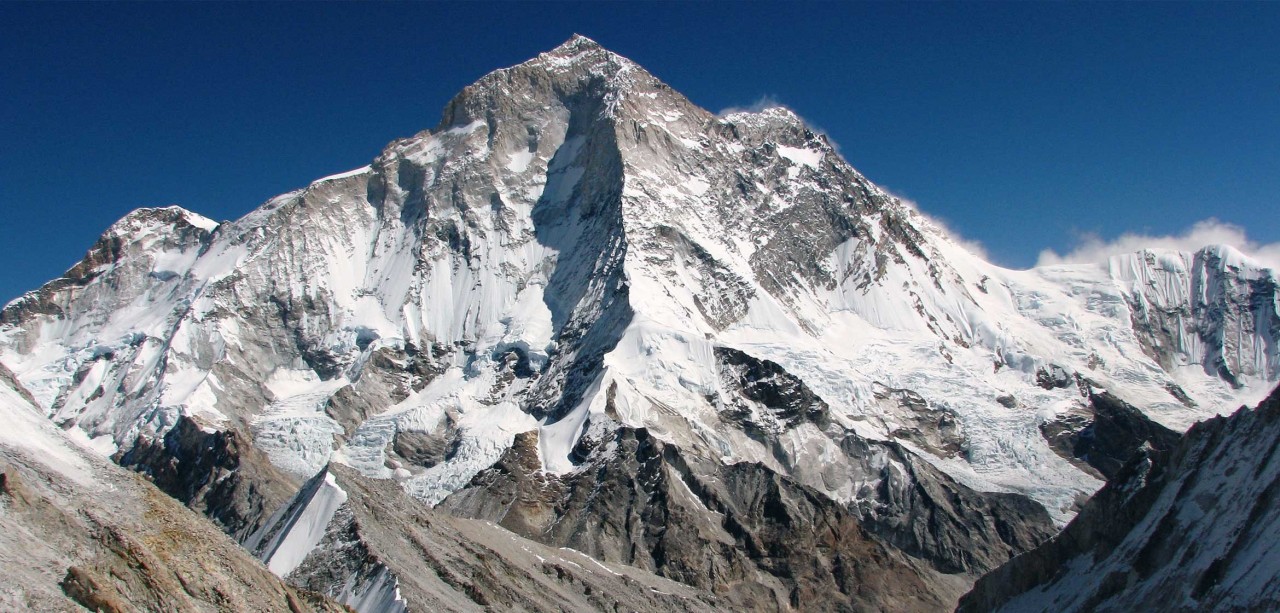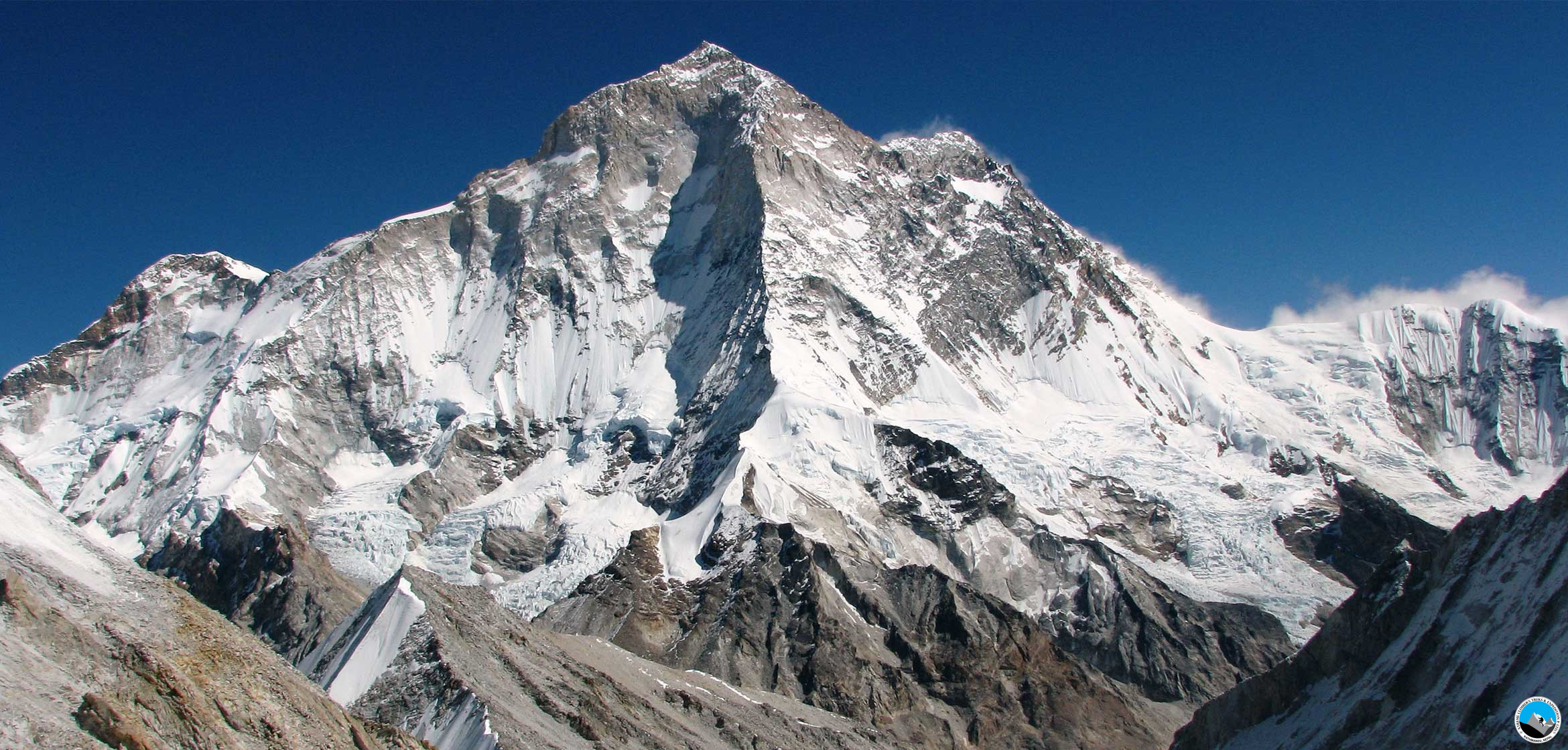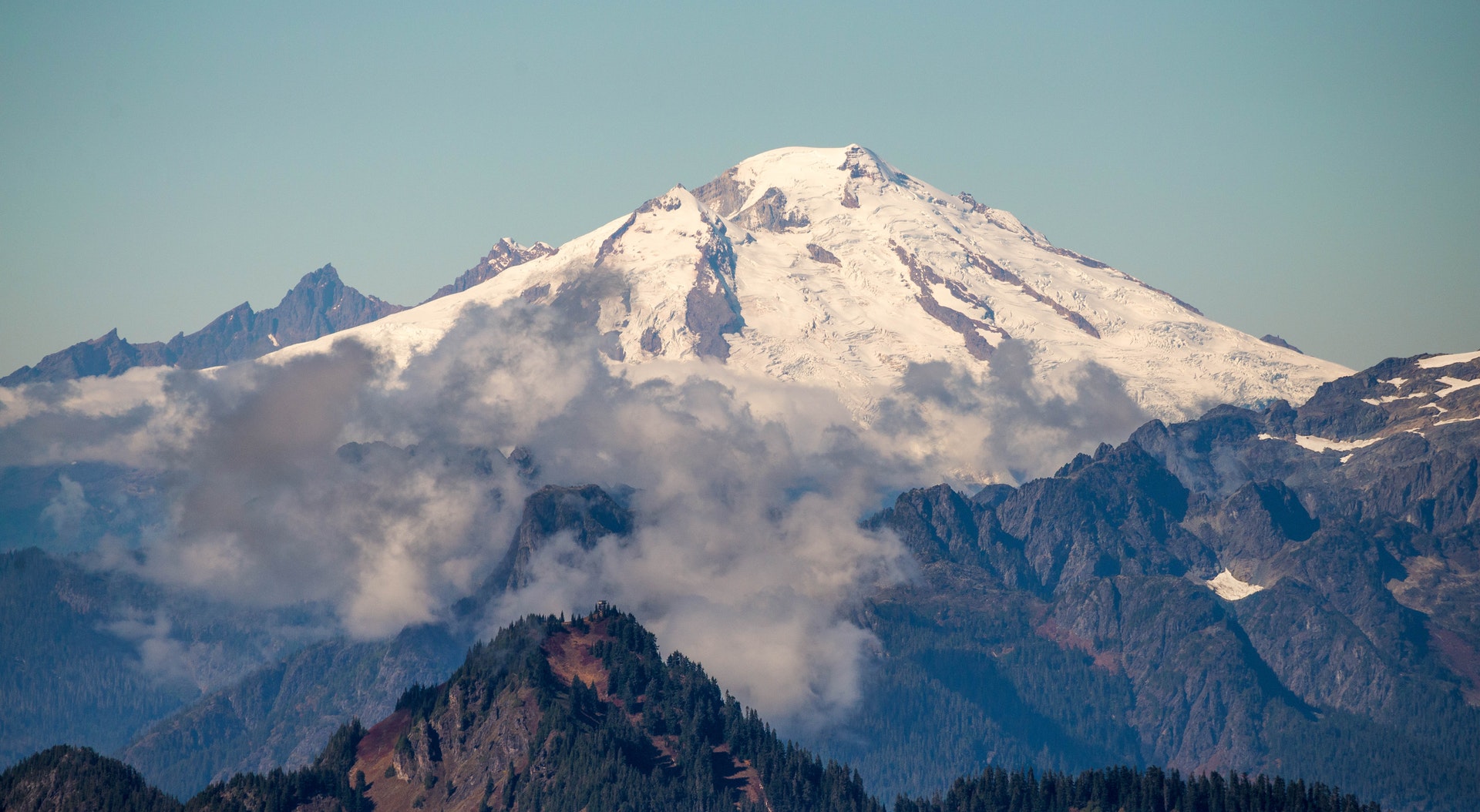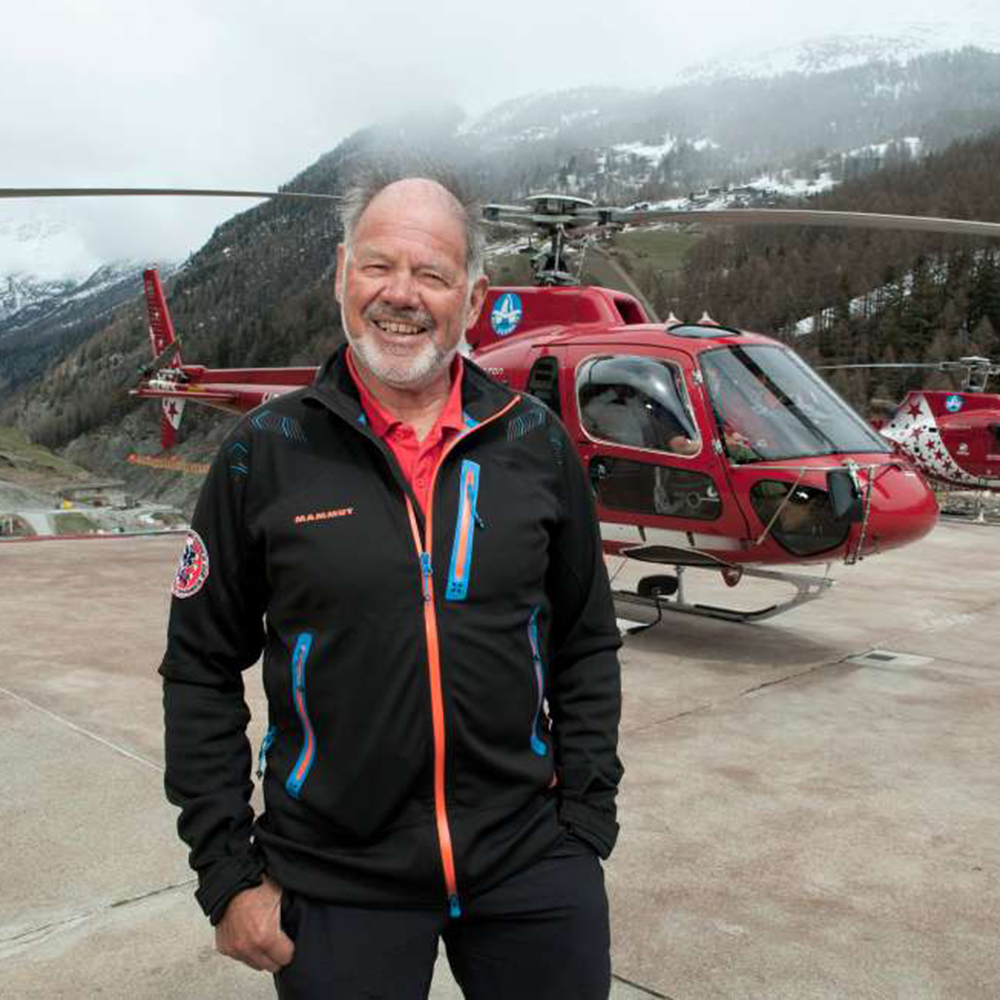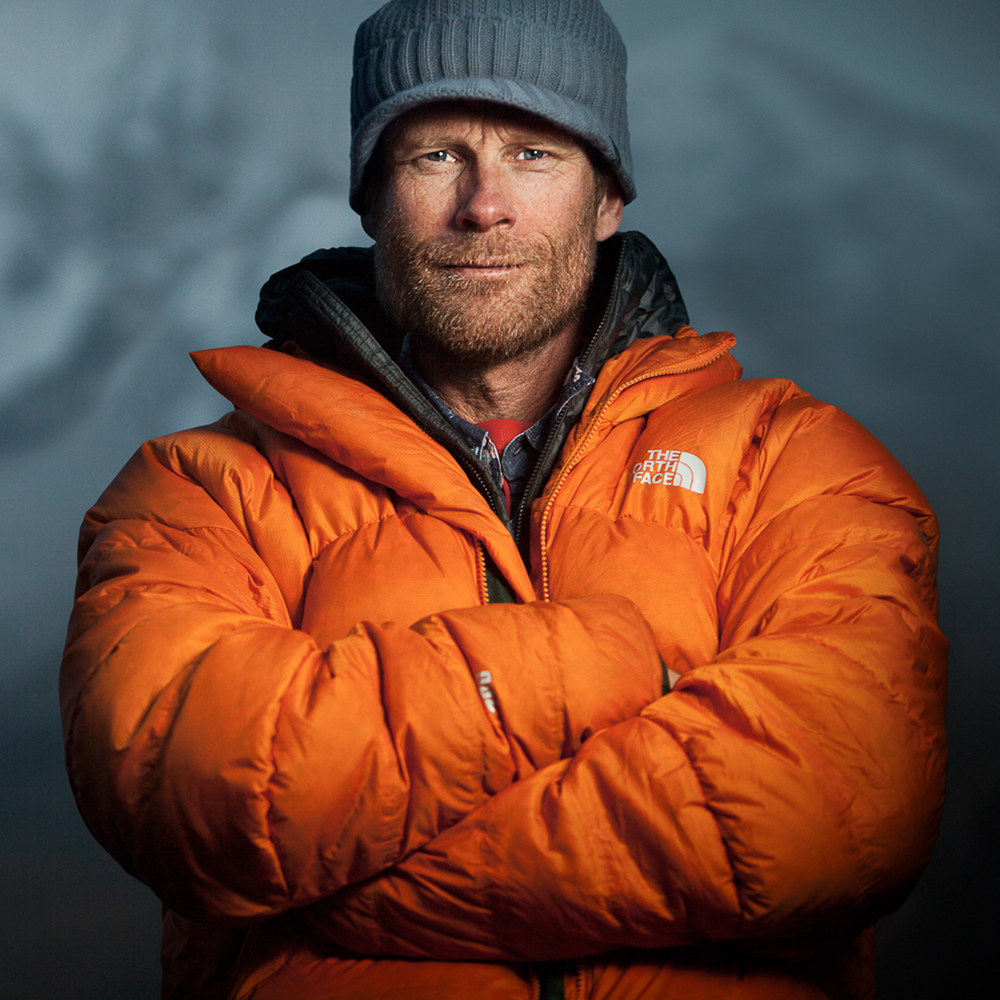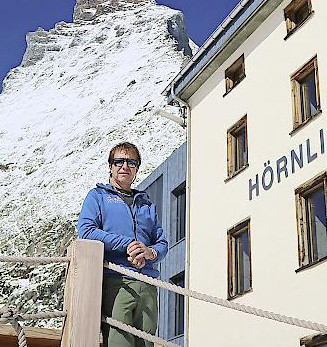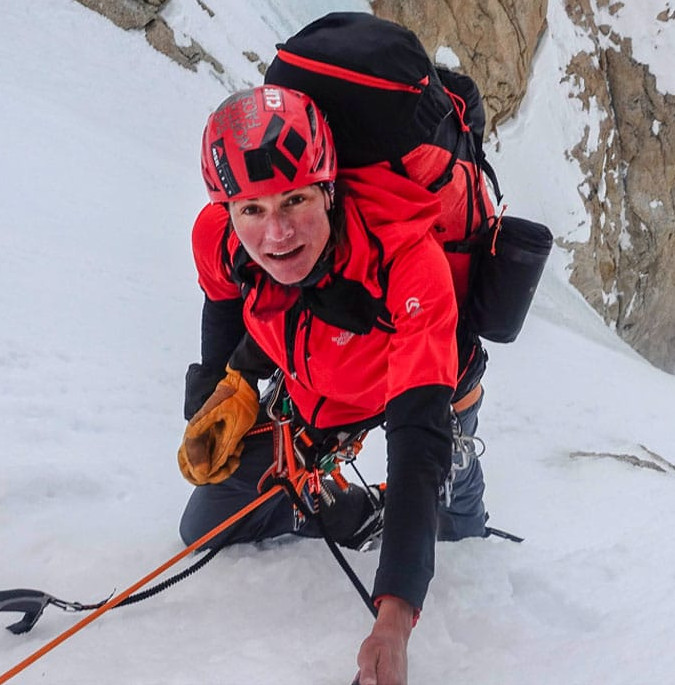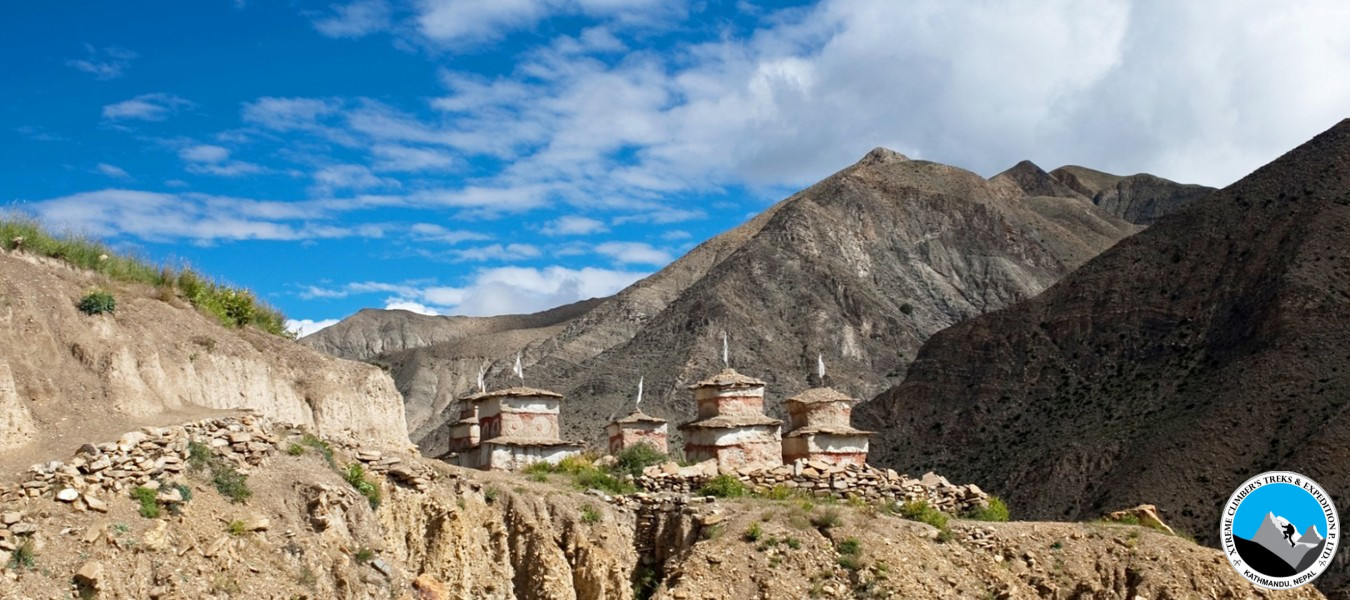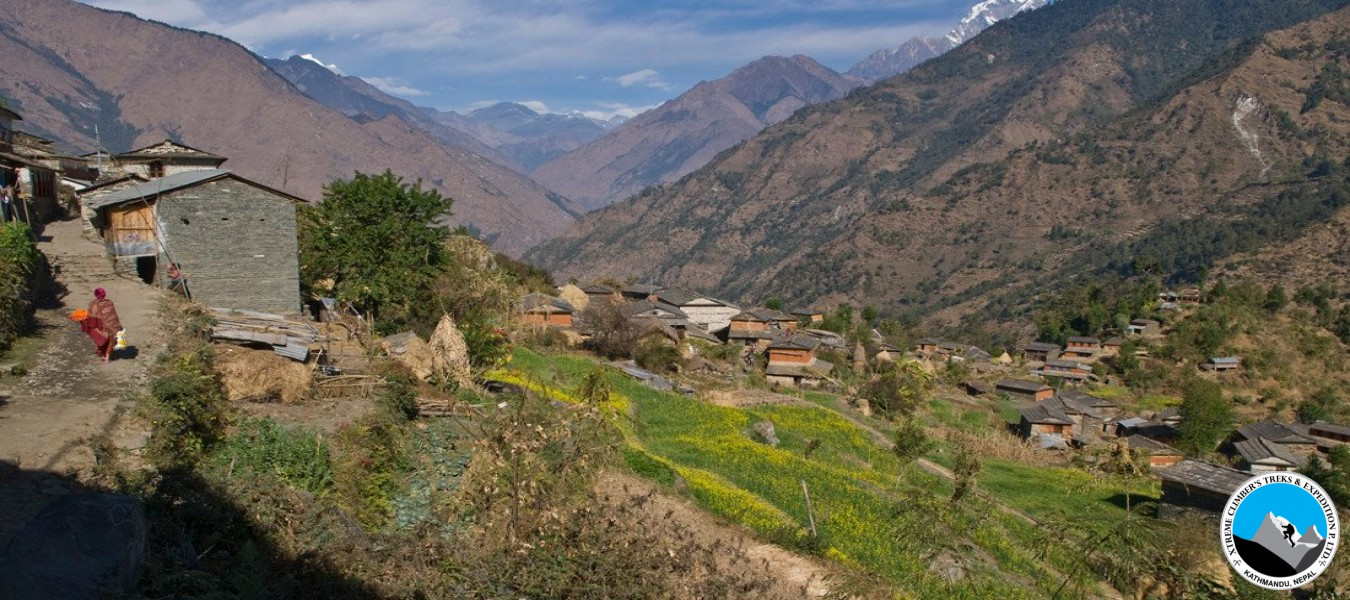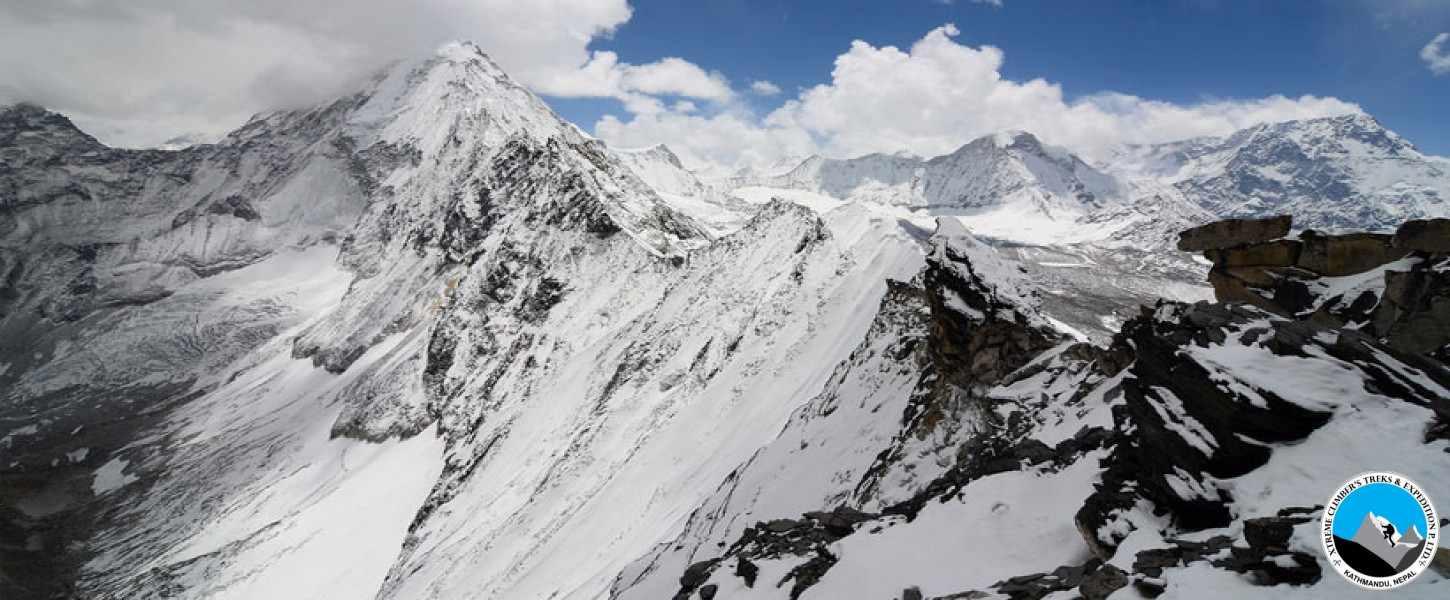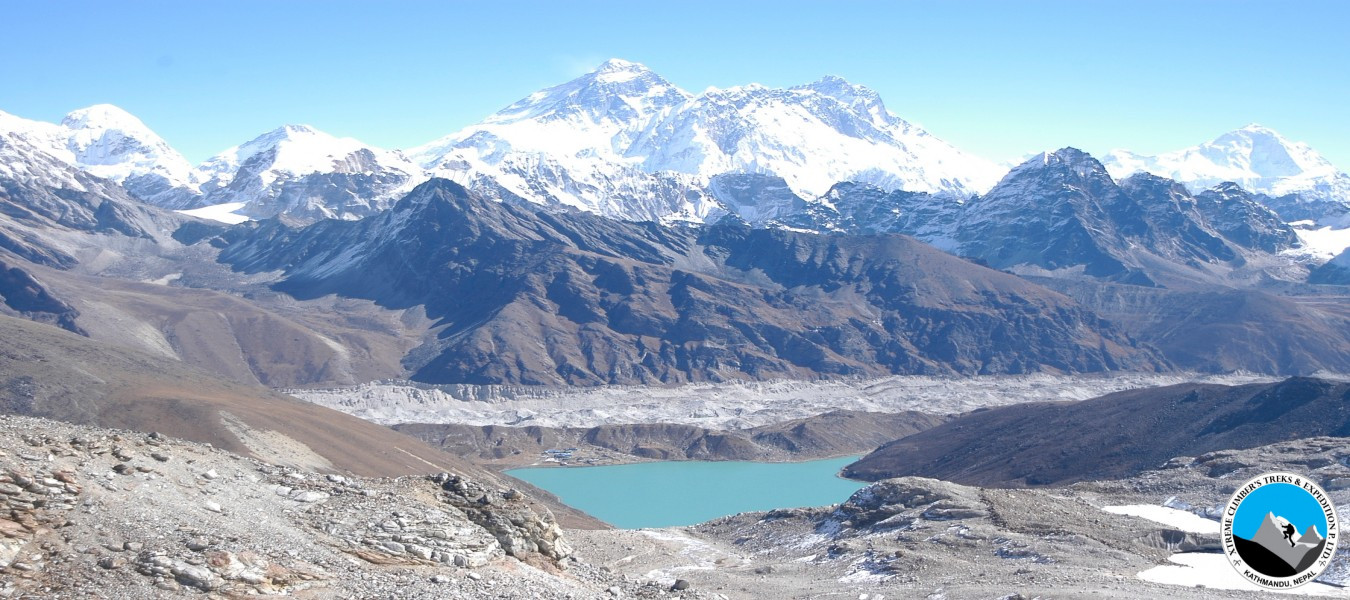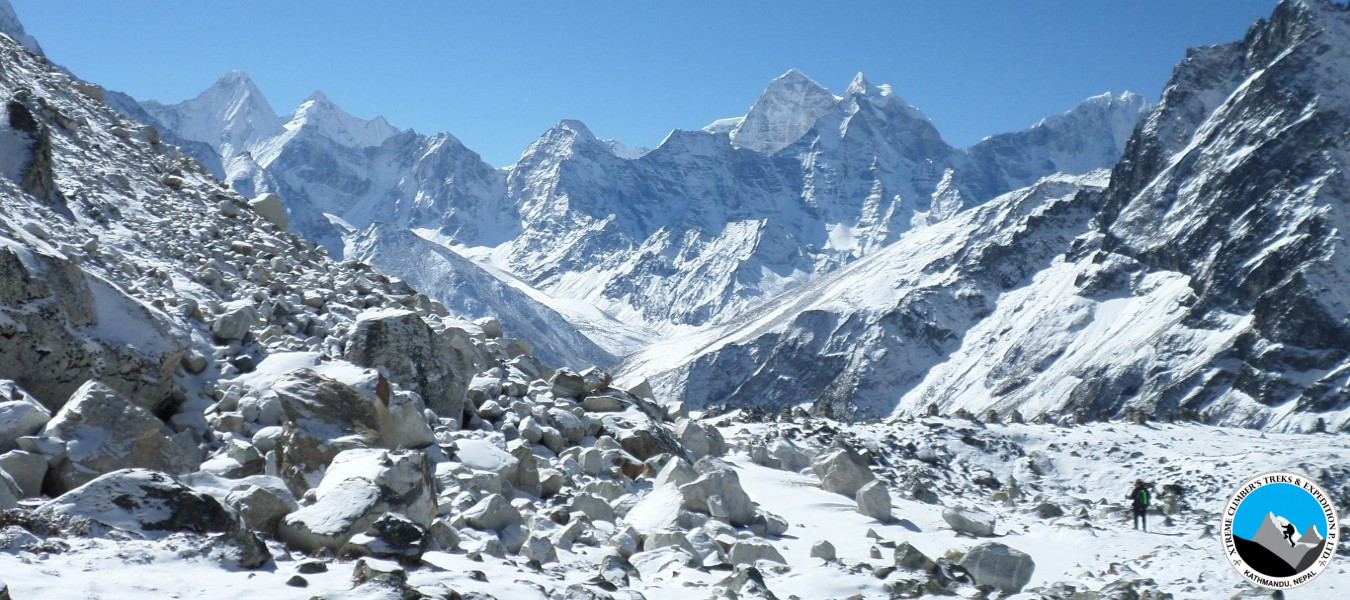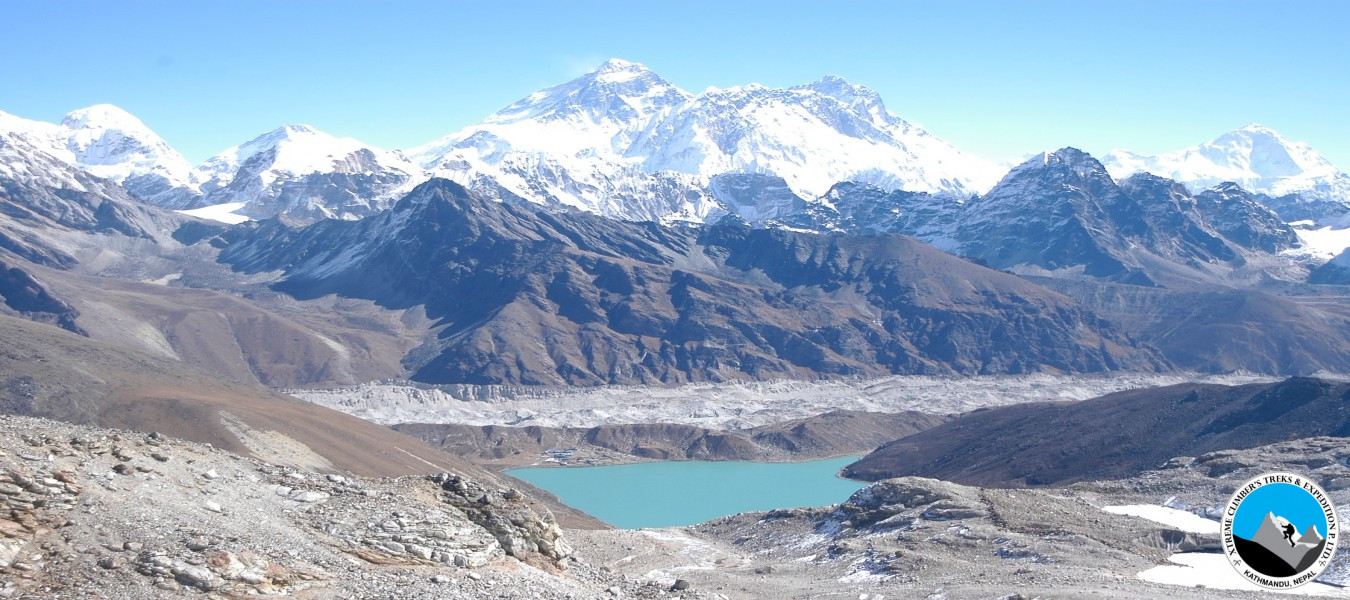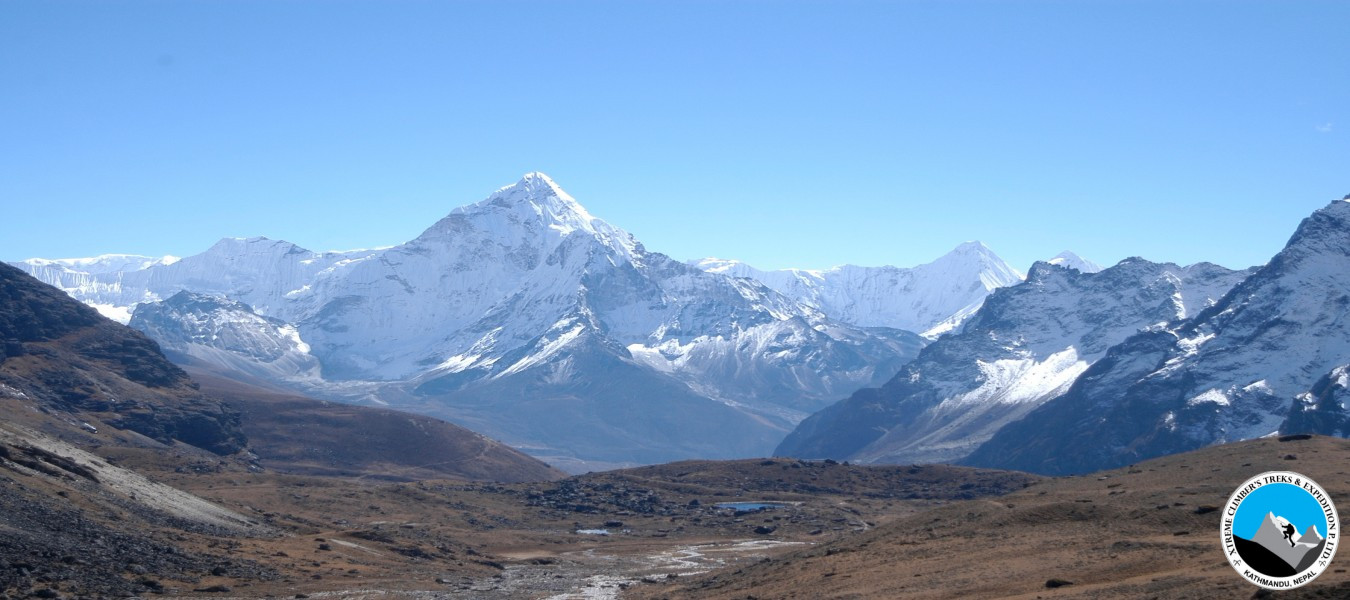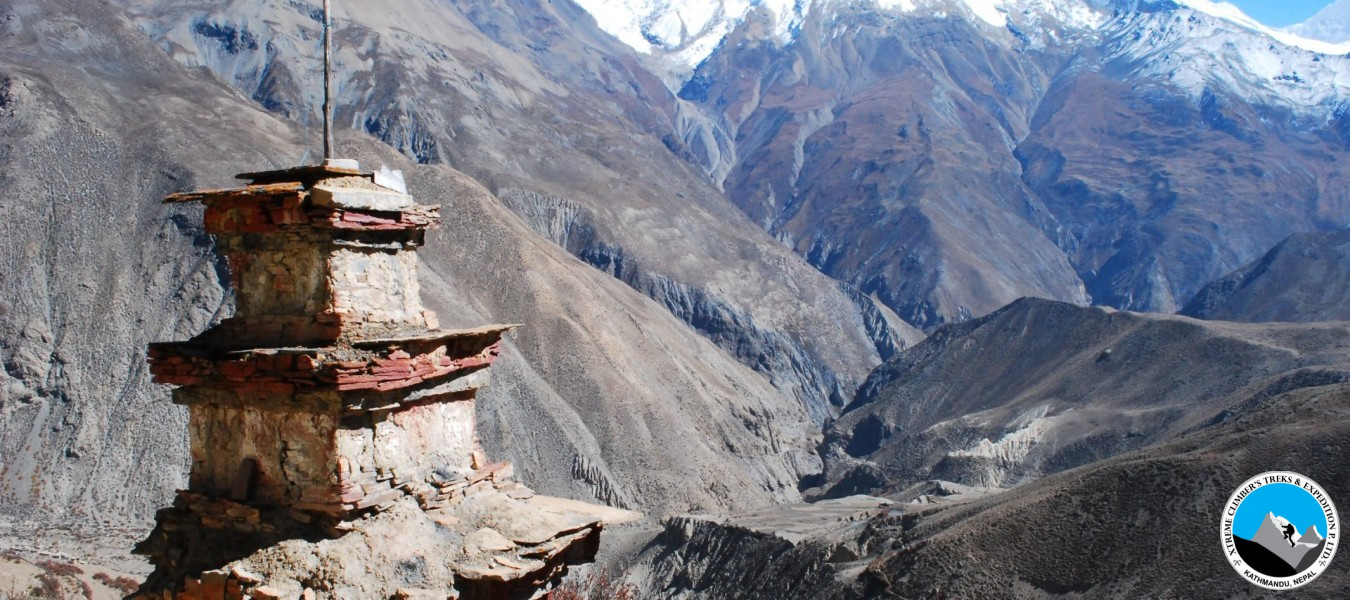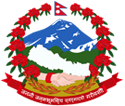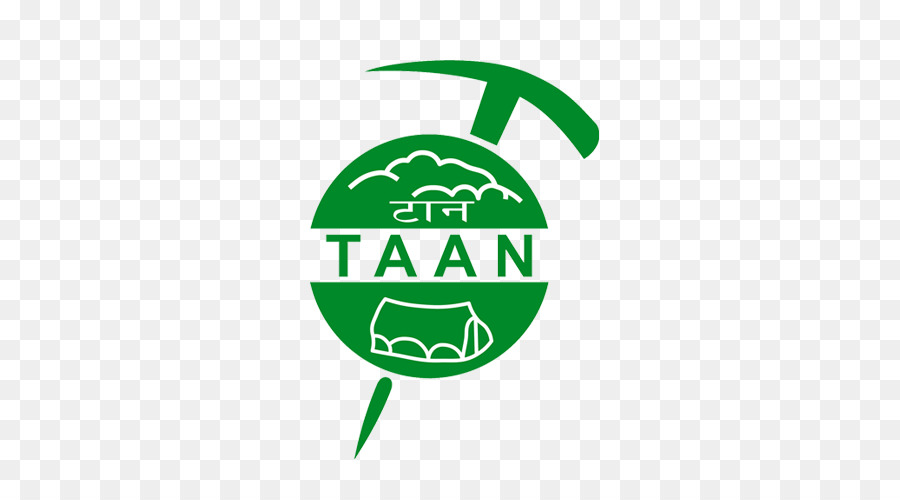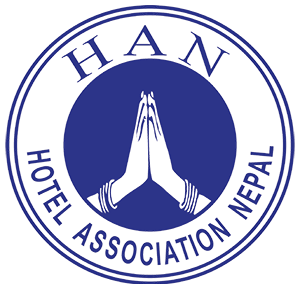The Makalu Sherpani Col Trekking to Everest Traverse Trek includes three high passes, two of them over 6,000m. It traverses the mountain range between Makalu and Everest. This trek combines cross-country trekking with mountaineering (fixed ropes and ice axe) to scale the high passes of the “Three Cols” – namely Sherpani Col, West Col and Amphu-Labsta. This trek forms part of the Great Himalayan Trail, a trail which crosses the country from east to west through some of the toughest and most beautiful landscapes provide an amazing view of the world's tallest mountains like Kanchenjunga 8,586 m, Makalu I 8,481 m, Makalu II 8,463 m, Mt. Kumbhakarna 7710 m. ( known as Jannu) , Baruntse 7129 m, Lhotse 8516 m, Everest 8,848 m, Pumori 7,161 m, Ama Dablam 6,812 m, & Thamserku 6,623 m. From Base Camp of Baruntse. One of the most challenging sections of the GHT, an excellent level of fitness is required to complete the journey, the majority of days at altitudes over 4,000 and up to 6,000m. Well equipped and professional team is highly required for this Adventure Trekking into the Himalayas.
Download Pdf
-
April-May & Oct-Nov
-
Kathmandu (Capital of Nepal)
-
Hotel/Camping/Tea House
-
Flight/ Private car in City
-
Each day 3 times meals will be provide by professional cook during Camping.
-
Helicopter : AS 350 B3E (H125)
- Capacity : 1 pilot + 6 Passengers
- Max takeoff weight : 2250 kg
- Power Plant : 1 Turbomeca Arriel 2D
- Service Sling : 23000 Ft
- Rate of Climb : 1818 fpm
- Cruising Speed : 137 knots
- Call Sign: 9N – AKP & 9N AKG
-
Day 1 : Arrive at Tribhuvan International Airport (KTM) Kathmandu
-
Day 2 : Trek preparation.
Included meals:Breakfast Dinner
-
Day 3 : Fly to Tumlingtar (950m/3,116ft), 40 minutes flight and drive to Chichila (1,800m/5,904ft), Via Mani-Bhanjyang (1,200m/3,936ft).
Included meals:Breakfast Lunch Dinner
-
Day 4 : Trek to Num (1,500m/4,920ft) 5-6 hrs walk.
Included meals:Breakfast Lunch Dinner
-
Day 5 : Trek to Seeduwa (1,493m/4,897ft), 5 hrs walk.
Included meals:Breakfast Lunch Dinner
-
Day 6 : Trek to Tashi Gaun (2,200m/7,216ft), 3-4 hrs walk.
Included meals:Breakfast Lunch Dinner
-
Day 7 : Trek to Kahuma Danda (3,500m/11,480 ft), 5-6 hours walk.
Included meals:Breakfast Lunch Dinner
-
Day 8 : Trek to Mumbuk (3,400m/11,152ft) 5-6 hrs walk.
Included meals:Breakfast Lunch Dinner
-
Day 9 : Trek to Nehe Kharka (3,750m/12,300ft) 6-7 hrs walk.
Included meals:Breakfast Lunch Dinner
-
Day 10 : Trek to Sherson (4,600m/15,088ft) 6-7 hrs walk.
Included meals:Breakfast Lunch Dinner
-
Day 11 : Acclimatization day.
Included meals:Breakfast Lunch Dinner
-
Day 12 : Trek to Barun-che Base Camp (4,800m/15,744ft), 2-3 hrs walk.
Included meals:Breakfast Lunch Dinner
-
Day 13 : Trek to High Camp (5,200m/17,056ft), 4-5 hrs walk.
Included meals:Breakfast Lunch Dinner
-
Day 14 : Camp at (5,700m/18696ft), 4-5 hrs walk
Included meals:Breakfast Lunch Dinner
-
Day 15 : Rest day. O/N Camp.
Included meals:Breakfast Lunch Dinner
-
Day 16 : Camp on the Moraine (5,640m/18,500ft), after crossing Sherpani col.
Included meals:Breakfast Lunch Dinner
-
Day 17 : Trek to Panch Pokhari (5,480m/17,975 ft), 4-5 hrs walk.
Included meals:Breakfast Lunch Dinner
-
Day 18 : Trek to Amphu Labtsa Base Camp.
Included meals:Breakfast Lunch Dinner
-
Day 19 : Traverse Amphu Labtsa Pass 5,780m and trek to Chhukung (4,730m/15,515ft), 7-8 hrs walk.
Included meals:Breakfast Lunch Dinner
-
Day 20 : Trek to Tengboche (3, 867m/12.684ft) 5-6 hrs.
Included meals:Breakfast Lunch Dinner
-
Day 21 : Trek to Namche Bazaar (3,440m/11,283ft) 5-6 hrs walk.
Included meals:Breakfast Lunch Dinner
-
Day 22 : Trek to Lukla (2,800m/9,184ft), 6-7 hrs walks.
Included meals:Breakfast Lunch Dinner
-
Day 23 : Fly back to Kathmandu Leisure at Kathmandu Farewell diner.
Included meals:Breakfast Dinner
-
Day 24 : Final Departure
Note: The above itinerary can be tailor made as per client's request, we can make the itinerary shorter/Longer by cutting or adding days, People who have longer time can add the White Water Rafting, Jungle safari tour in Chitwan National park, Paragliding and Zeep Flyer in Pokhara and other extra activities so feel free to write us on info@xtremeclimbers.com for further details.How to book a trip ?
Full Board Service Includes
- Necessary ground transfers by private vehicle as per itinerary.
- Guided sightseeing in Kathmandu (includes all entrance fees).
- Three star Hotel in Kathmandu (including Breakfast, & Taxes)
- All domestic airfares (Kathmandu - Tumlingtar & Lukla- Kathmandu).
- Organized Camping Trek arrangement, including all high quality camping equipments and VE-25 North-Face Two Men Tent, Kitchen Tent, Toilet Tent, Table, Chairs, Mattresses, Hot Water Bags, Inner Sheet and etc.
- Solar Panel for Light and battery charging in Base Camp.
- Thuraya SAT Phone for emergency use only.
- Radio Walki Talki
- Fresh meals will be provided (as long as it possible) while trekking, High quality hygienic food will be provided over high passes which will be prepared by our cook.
- National Park / Conservation Area Permit Fees ( Included: Gawn Palika, Sagarmatha National Park & Makalu Barun Conservation Area).
- Highly experienced Climbing Sherpa (Everest Summiters) / Assistant guide, High altitude working crew / Necessary required high altitude porters to carry your backpack (1 porters for 2 member 30.kg max) / with their daily wages, insurance and all arrangements.
- Guide, porters and their daily wages, insurance with all necessary lodging - fooding arrangements.
- Welcome Dinner with Live Nepalese Cultural Program.
Cost and payment details
The cost is depending on group size, affected due to the requirement of number of guides and porters, requisite of Hotel in Kathmandu, method of land/air transport. The itinerary is changeable and modifiable as per needs and time frame of trekkers. Cost will be re calculated if the itinerary is changed or modified. Additional activities may be added as per trekkers request with appropriate additional cost. For Total Tour cost EMAIL US, we will send you within 24 hours as your requirements.
Why we dont't include cost in our website?
NOTE: To provide you service in reasonable cost and attempt to address your each requirement Xtreme Climbers desired to provide you with some information which directly affects the cost and also helps us breakdown the cost. That is why we have decided to clarify our customers that due to the following reasons mentioned below we have not included the cost of each package in the company website.
-
Climbing season: The climbing permit royalty cost for mountain will be different during Spring and Autumn season. Normally most of the climbers climbs Himalayas in the Spring season. Climbing permit during Autumn will be 50% less than the spring season.
-
The cost of the trip depends on Number of persons joining in group for High expedition or Mountain Climbing including number of climbers, non-climber, base camp supporters, medical doctors, The number of climbing Sherpa guides, high altitude porters, kitchen crew, mode of transport you prefer and many other factors can affect the cost of the trip. Alpine climbing guide as well as the category of the hotel accommodation and the facilities that you aspire in the mountains affect the cost.
-
We operate the High Expeditions, Peak Climbing in full arrangement package and basic arrangement service (full board or base camp service) which directly affects the expedition cost.
-
Request numbers of oxygen, mask regulators and the brands the clients require
-
The itinerary may be changed after reaching an understanding between the agency and the client. Other activities could be added or reduced as per the client's request before processing the trip. Price for reduced activities could be deducted and additional activities could be added in mutual understanding.
-
Either you want to operate this expedition as international group joining basics of Xtreme Climbers or individual (private arrangement) expedition.
-
Type of high camp food that clients require. Any specialized food that has to be ordered from foreign countries will be costlier compared to the one available here.
-
Either any of the climbers intend to attempt any world records? If so, do they require special services or equipment?
Due to the reasons mentioned above we would like to discuss with our client directly before offering the cost. So please feel free to drop your queries in info@xtremeclimbers.com or login to www.xtremeclimbers.com for any information about your selected package.
Full Board Service Excludes
- Nepalese visa fee
- International airfare to and from Kathmandu
- Excess baggage charges (if you have more than 15 kg luggage, cargo charge is around $1.5 per kg)
- Extra night accommodation in Kathmandu because of early arrival, late departure, early return from mountain (due to any reason) than the scheduled itinerary
- Altitude chamber (PAC) or oxygen
- Lunch and evening meals in Kathmandu (and also in the case of early return from the mountain than the scheduled itinerary)
- Travel and rescue insurance
- Personal expenses (phone calls, internet, laundry, bar bills, battery recharge, extra porters, bottle or boiled water, shower, etc.)
- Personal climbing equipment
- Personal climbing guide if requested
- Optional trips and sightseeing if extended
- Tips for guides and porters
- Services not listed in the ‘What Is Included’ section
Cost and payment details
The cost is depending on group size, affected due to the requirement of number of guides and porters, requisite of Hotel in Kathmandu, method of land/air transport. The itinerary is changeable and modifiable as per needs and time frame of trekkers. Cost will be re calculated if the itinerary is changed or modified. Additional activities may be added as per trekkers request with appropriate additional cost. For Total Tour cost EMAIL US, we will send you within 24 hours as your requirements.
Altitude Sickness
Acute Mountain Sickness (AMS) is common at high altitudes sickness. In general may occur when people ascend too quickly normally in altitudes of over 3000 m. The symptoms of altitude sickness are due to lower air pressure at high altitudes, which results in lower oxygen levels as you breathe the air in. The air is under less pressure and this makes it harder for your body to get the oxygen out of the air and into the circulation. It's this extra strain on the body that causes altitude sickness.
Symptoms tend to be worse at night and include headache, dizziness, and lethargy, loss of appetite, nausea, breathlessness and irritability. Difficulty sleeping is another common symptom.
The major symptoms of altitude sickness
Initial symptoms
- Periods of sleeplessness
- Runny nose.
- Extra tiredness
- Occasional loss of appetite
- Feeling laziness
- Wish to vomiting
- Periodic breathing
Above are normal symptoms which may occur into your body that you should not be worried. Every trekker will experience some or all of these, no matter how slowly they ascend.
Advance symptoms
- Headache and vomiting
- Dizziness
- Racing heartbeat
- Exhaustion
- Nausea
- Diarrhoea
- Loss of apatite
- Weakness
- Hard to breath
- Extra tired
- Dry Raspy cough
- Sleeplessness
When above symptoms will occur into your body, these symptoms usually resolve by spending one or two extra nights at the same altitude or using medicine. Even you are resting at the same altitude or using medicine, if symptoms are becoming worse, then it is necessary to descend.
Serious Symptoms
- Worsening headache and vomiting
- Swelling of hands and face
- Reduced urine output
- Walking with a staggering gait
- Confusion
- Increased tiredness
- Breathing irregularity
- Visual hallucinations (seeing things that are not real)
- Changes in the ability to think
- Changes in normal behavior
If above serious symptoms will occur into your body, these extremely dangerous symptoms are called High Altitude Cerebral Edema (or HACE). They can lead to unconsciousness and death within 12 hours. Increasing shortness of breath, cough and tiredness may also be signs of High Altitude Pulmonary Edema or HAPE. HAPE can also be rapidly fatal if ignored.
To prevent acute mountain sickness:
- If possible, don't fly or drive to high altitude. Start below 3,000 metres (10,000 feet) and walk up.
- If you do fly or drive, do not overexert yourself or move higher for the first 24 hours.
- If you go above 3,000 metres (10,000 feet), only increase your altitude by 350 to 500 metres (1,000 feet) per day
- Climb high and sleep low! You can climb more than 300 to 500 metres in a day as long as you come back down and sleep at a lower altitude.
- If you begin to show symptoms of moderate altitude sickness, don't go higher until symptoms decrease.
- Drink plenty of water, tea or juice etc (at least three to 4 liters per day). Urine output should be copious and clear to pale yellow.
- Eat high-carbohydrate foods (rice, pasta, cereal) for more energy.
- Take it easy and don't overexert yourself when you first get up to altitude. But, light activity during the day is better than sleeping because respiration decreases during sleep, exacerbating the symptoms.
- Avoid alcohol as it may increase the risk of dehydration, and don't smoke.
- Don't push yourself when climbing up to passes, rather take plenty of breaks.
- Avoid taking sleeping pills.
- Avoid active movements and try to relax in the first one or two days upon arrival at the high altitude areas.
- Bring adequate medicine.
- If nothing else works, return to the areas with the lower elevation.
- Allow sufficient time for acclimatization (After 3000 meters).
- Don’t make rapid Ascent. Don’t go too far too fast.
- Do not trek/travel alone, take guide/porter.
- Follow the advice from your guide, hotel, local, guide book.
- Descent if mild symptoms rapidly getting worse.
- Never leave or descent sick person along.
- Avoid getting cold.
- Take an easy and comfortable trekking route even if its longer
Medicine:
Following is a list of items you should consider including in your medical kit - consult your pharmacist for brands available in your country.
- Aspirin or paracetamol - for pain or fever
- Antihistamine - for allergies, eg hay fever; to ease the itch from insect bites or stings; and to prevent motion sickness.
- Antibiotics consider including these if you're traveling well off the beaten track' see your doctor, as they must be prescribed, and carry the prescription with you.
- Loperamides or Diphenoxylate 'blockers' for diarrhea' Prochlorperazine or metaclopramide for nausea and vomiting.
- Rehydration mixture to prevent dehydration, eg due to severe diarrhea; particularly important when traveling with children.
- Insect repellent, sunscreen, lip balm and eye drops.
- Calamine lotion, sting relief spray or aloe vera-to ease irritation from sunburn and insect bites or stings.
- Antifungal cream or powder - for fungal skin infections and thrush.
- Antiseptic, such as povidone-iodine for cuts and grazes.
- Bandages, band-aids or plasters and other would dressings.
- Scissors, tweezers and a thermometer (note that mercury thermometers are prohibited by airlines)
- Cold and Flu tablets, throat lozenges and nasal decongestant.
- Multivitamines - consider for long trips, when dietary vitamin intake may be inadequate.
Note: We have guides trained at the High Altitude Medical Training Center. Our staff is very experienced in dealing with the effects of higher altitudes. As they are natives of Nepal, they easily acclimatize and therefore can care for their clients. They are equipped with necessary medical supplies and will assist you with basic first aid treatment. We design our tours to ensure clients are ready for high altitude, and arrange alternative itineraries for those at risk
Insurance
Travel insurance is compulsory for all Clients undertaking any tour. It should provide adequate protection for the full duration of the tour to cover personal injury, medical expenses, repatriation expenses, helicopter evacuation, loss of luggage, etc.
For your kind information, we would like to give a list of the insurance companies, please go through the links below:
Footwear
| Trekking Boot |
1 Pair |
| Thick Socks |
4 Pairs |
| Light Socks |
3 Pairs |
| Camp Shoes |
1 Pair |
| Sandals |
1 Pair |
Other Equipments
| Sleeping Bag(4seasons) |
1 |
| Down Jacket |
1 |
| Daypack |
1 |
| Water Bottle |
1 |
| Sun Cream |
|
| Sunglasses |
|
| Flashlight With Spare Bulbs, Batteries, Lip Salve, Gaiters. |
|
Clothing
| Down Or Fiber Filled Waterproof Jacket And Trousers |
1 |
| Fleece Jacket Or Pullover |
1 |
| Warm Cotton Trousers |
2 Pairs |
| Shirts And T-Shirts |
4 Pieces |
| Lightweight Cotton Long Pants |
3 Pairs |
| Long Under Wear |
2 Pieces |
| Short Under Wear |
4 Pieces |
| Sun Hat Or Scarf |
1 |
| Woolen Hat |
1 |
| Sunglasses |
1 |
| Lightweight Gloves |
1 |
| Rain Coat |
1 |
| Heavyweight Gloves Or Mittens With A Waterproof |
1 |
Optional
| Insect Repellent |
| Toilet Articles |
| Note Book & Pen |
| Toilet Roll |
| Laundry Soap |
| Pocket Knife |
| Towel |
| Sewing Kit |
| Plasters |
| Binoculars |
| Camera |
| Film |
| Cards And Personal Medical Kit |
-
What happens if I need to leave the trip early?
-
What are some basic Nepali customs that I should know about?
-
Are there ATM facilities in Nepal?
-
What about water - are they available at each teahouse? I know we supposed to bring iodine tablets.
-
Is there any communication while we are on trekking?
See More
